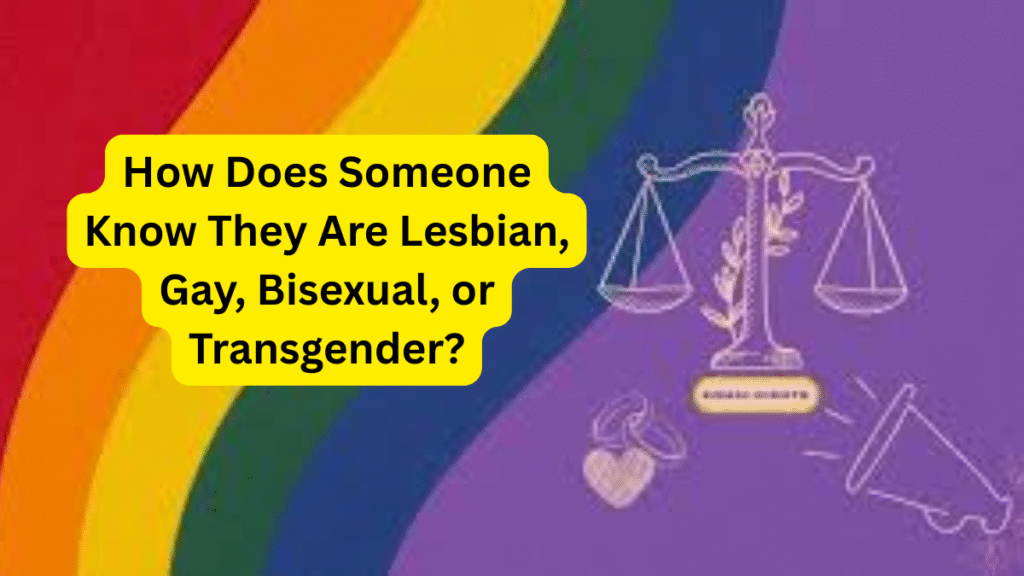How Does Someone Know They Are Lesbian, Gay, Bisexual, or Transgender : Understanding your sexual orientation or gender identity is a deeply personal journey of self-discovery, not a single moment of realization
How Does Someone Know They Are Lesbian, Gay, Bisexual, or Transgender?
Understanding your sexual orientation or gender identity is a deeply personal journey of self-discovery, not a single moment of realization. There is no one-size-fits-all test; rather, it’s a process of tuning into your inner feelings, attractions, and sense of self. This guide will walk you through the common signs, feelings, and steps involved in this exploration, providing a supportive and authoritative resource for anyone questioning.
Exploring Sexual Orientation: Attraction and Identity
Sexual orientation is about who you are romantically, emotionally, and physically attracted to. Understanding it involves reflecting on your patterns of attraction throughout your life.
What Makes Someone Gay, Lesbian, or Bisexual?
The question of “what makes someone gay” has been the subject of much debate. The consensus in the scientific community is that there is no single cause. Sexual orientation is likely shaped by a complex interplay of genetic, hormonal, developmental, and social factors. Rather than seeking a cause, it’s more helpful to focus on understanding your own lived experience.
Common Signs of Same-Sex or Multi-Gender Attraction
- Consistent Feelings: Finding yourself repeatedly developing crushes or feeling drawn to people of the same gender.
- Emotional Connections: Feeling a deeper sense of fulfillment, understanding, or “spark” in relationships with people of a particular gender.
- Questioning Heteronormativity: Feeling that the expectation to be with someone of a different gender doesn’t fit your reality.
- Fantasy and Media: Noticing that you are more engaged by or identify with LGBTQ+ characters and storylines.
Is Being Gay Genetic or Environmental?
The debate of “is being gay genetic or environmental” is often oversimplified. Research, including studies on twins, suggests a biological predisposition, but it’s not determined by a single “gay gene.” Environmental factors in this context refer to conditions in the womb and broader social experiences, not upbringing or parenting. Ultimately, sexual orientation is an innate part of a person, not a choice.
Understanding Gender Identity: The Inner Self
Gender identity is your internal, deeply held sense of your own gender. For transgender people, this sense does not align with the sex they were assigned at birth.
How Do Trans People Know They Are Trans?
The process of how do trans people know they are trans is unique to each individual, but it often involves a feeling of persistent discomfort or incongruence, known as gender dysphoria. This can manifest as:
- A deep-seated feeling that your body is wrong.
- Discomfort with social roles and expectations tied to your assigned gender.
- A strong desire to be perceived and treated as a different gender.
- Conversely, a feeling of “rightness” or gender euphoria when expressing your true gender.
Understanding the Transgender Experience
To understand this fully, it’s important to know the basic definitions.
What is a transgender woman?
A transgender woman is a person who was assigned male at birth but whose gender identity is female. She may transition socially (changing her name, pronouns, and appearance) and/or medically (through hormones or surgery) to align her transgender body with her internal identity.
What is a transgender man?
A transgender man is a person who was assigned female at birth but whose gender identity is male. He undertakes a similar journey of social and/or medical transition to live authentically as a man.
A Step-by-Step Guide to Self-Reflection
If you are questioning, here is a supportive framework to guide your exploration.
- Create a Quiet Space for Reflection: Find a time to be alone with your thoughts without pressure.
- Journal Your Feelings: Write down your thoughts on attraction and identity. When have you felt most like “yourself”? What kinds of people do you admire or feel drawn to?
- Explore Safely: Experiment in a low-risk way. This could mean joining an online LGBTQ+ forum, trying out different pronouns with a trusted friend, or expressing yourself through clothing or hairstyle.
- Find Your Community: Connect with other LGBTQ+ people, either online or through local support groups. Hearing others’ stories can provide immense clarity and validation.
- Be Patient and Kind to Yourself: This is a marathon, not a sprint. There is no deadline for self-discovery. Your feelings are valid, and your journey is your own.
Frequently Asked Questions (FAQ)
Q1: What are the main “causes of homosexuality”?
A: Leading medical and psychological organizations state that sexual orientation is not a choice and is likely caused by a complex mix of biological, genetic, and environmental factors. The focus should be on acceptance, not causation.
Q2: Are there different “types of homosexuality”?
A: The term “types of homosexuality” is outdated. We now use more precise terms like gay, lesbian, and bisexual to describe attraction. Other identities on the spectrum, like pansexual or asexual, further describe the diverse ways people experience attraction.
Q3: What does it mean if my feelings change over time?
A: This is completely normal and is often described as sexuality or gender being “fluid.” Your identity can evolve, and that doesn’t make your past feelings any less valid.
Q4: I feel scared and confused. Is that normal?
A: Absolutely. Questioning a core part of your identity can be daunting due to societal stigma. Your feelings are normal, and support is available.
Q5: When should I consider talking to a professional?
A: If you are feeling significant distress, anxiety, or depression related to your gender or sexuality, seeking out a therapist who specializes in LGBTQ+ issues can be incredibly helpful.
You Are Not Alone: Find Support and Community
Your journey of self-discovery is valid and important. Remember, you don’t have to have everything figured out right away. For further support, education, and community, please explore the following official resources. They offer confidential help, information, and connections to affirming communities.
